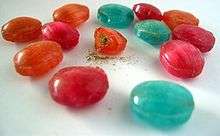Tyrkisk Peber

Tyrkisk Peber (Danish for "Turkish Pepper", often referred to as "Turkinpippuri" in Finland, "Tyrkisk pepper" in Norway, "Turkisk peppar" in Sweden and "Türkisch Pfeffer" in Germany) is a strong liquorice candy flavoured with ammonium chloride (salmiakki) and pepper, made by the Finnish company Fazer and popular in Northern Europe. Tyrkisk Peber was originally invented by Per Fjelsten, his wife's name was Elly, therefore the company name Perelly, in 1976 [1] [2] and made by the Danish company Perelly, which was taken over by Fazer.
The basic variant is a large, hollow round shell both coated and filled with salmiakki powder. It is sold in dark blue bags. The Tyrkisk Peber product family has later expanded to include the "Hot & Sour" (a milder variant of the traditional design, produced in four different flavours) and "Bonfire" (soft, much milder candies) bagged variants, as well as lollipops and filled liquorice. There has also been a chilli flavoured version and a strongly licorice-flavoured version with less of the ammonium chloride and peppercorn flavouring, but these have since been discontinued. The licorice-flavoured variant can still be found as one of the flavours in the “Hot & Sour” bags, though. Tyrkisk Peber ice cream is sold by Hjem-IS in Norway, Sweden, Denmark and Iceland.[3]
Tyrkisk Peber is sometimes used to make the Finnish cocktail salmiakkikoskenkorva and similar Danish, Norwegian and Swedish cocktails. When Perelly manufactured Tyrkisk Peber, it was also available as powder. The powder was often used to make the cocktail, which in Denmark is known as sort svin, små grå, or hot shot, in Sweden as lakritsshot, and in Norway as tyrker, små grå, or lakrisshot.

Tyrkisk Peber is hygroscopic, and if left in an unsealed bag it will absorb water from the air and stick together after a few days. In Northern Europe there are competing different versions of this candy, including Pulverpadder (that looks like toads), Rustne søm and Spejder-Hagl.
References
- ↑ STT. "Turkinpippuri-makeisen keksijä palkittiin" (in Finnish). Helsingin Sanomat. Retrieved 2007-12-01.
- ↑ "Hvorfor hedder det Tyrkisk Peber?" (in Danish). Retrieved 2007-12-01.
- ↑ Hjem-IS - Voksenis
External links
- Product page (Norwegian)
- Fazer Website (Finnish)
- Product page (Finnish)
- Product page (Swedish) (alternate)